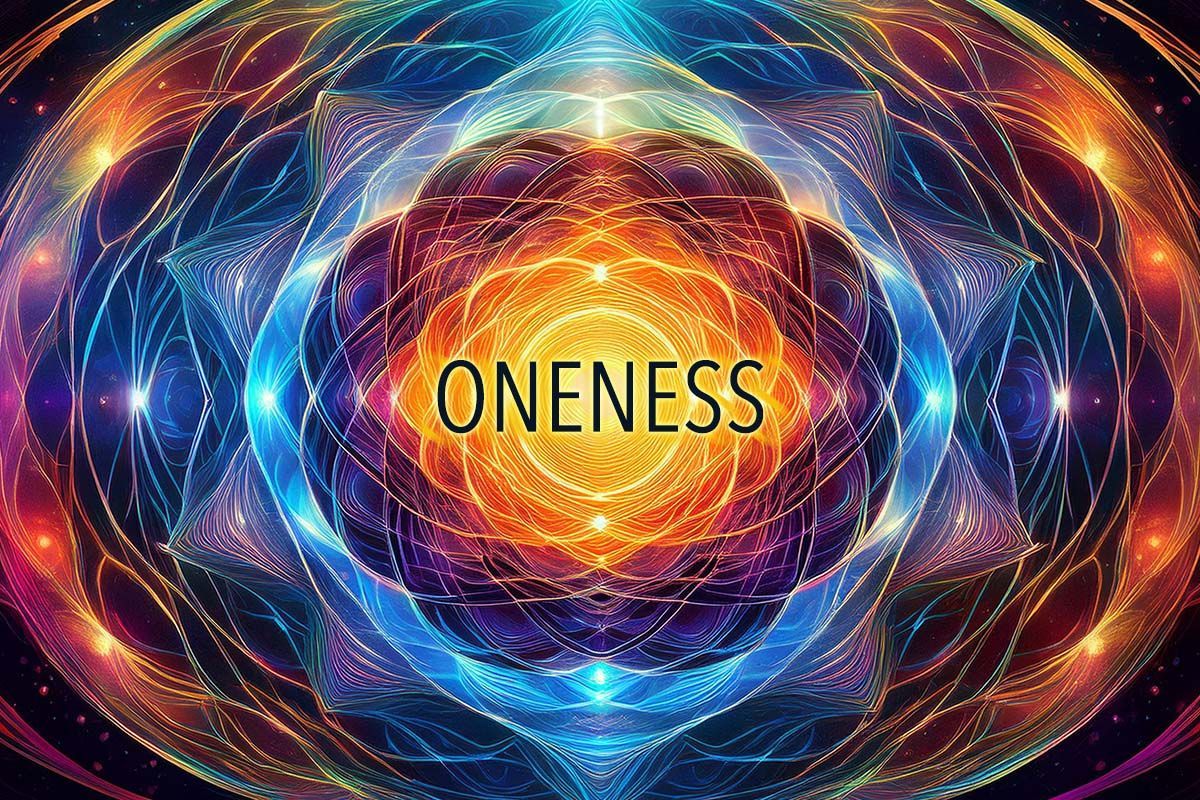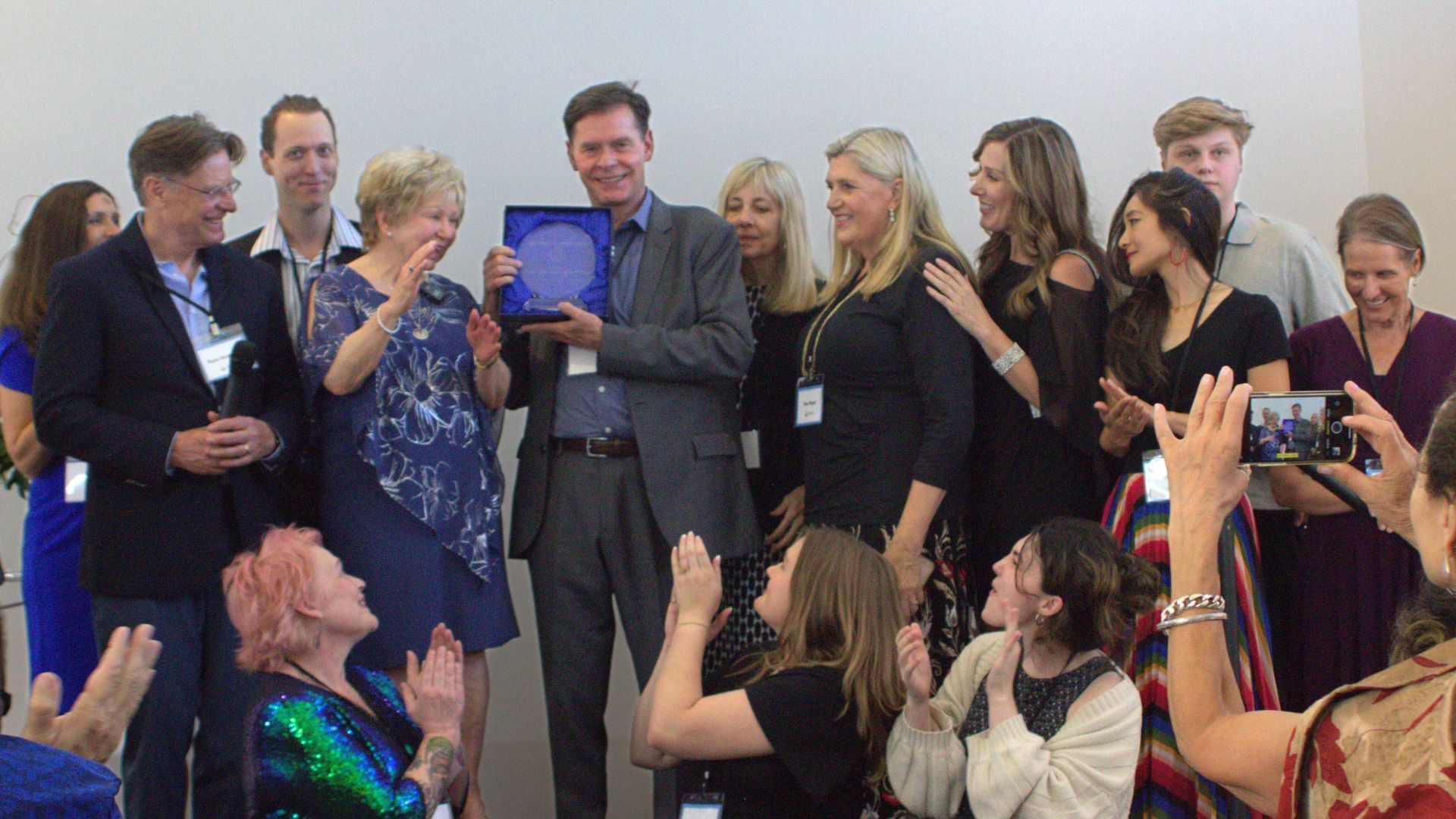
Why Heart-Centered Leadership is the Future of Business In today’s fast-paced business world, leaders are searching for innovative ways to build resilient, engaged, and high-performing teams. While traditional leadership models emphasize profit, efficiency, and competition, a new paradigm is emerging—one that is proving to be the key to long-term success. This model is heart-centered leadership , a philosophy that integrates spirituality, purpose, and conscious business practices. Companies that embrace a more holistic, heart-led approach are not just achieving financial success—they are fostering workplace cultures where employees feel valued, inspired, and aligned with a higher mission. The data is clear: employees who feel connected to a purpose beyond profit are more productive, loyal, and innovative. For decades, I’ve been privileged to work with global thought leaders, entrepreneurs, and visionaries who are reshaping how we define leadership. Through my work with Humanity’s Team , I’ve seen firsthand how integrating spirituality into business leadership doesn’t just create successful organizations—it creates movements. In this article, we’ll explore how heart-centered leadership elevates business performance, strengthens company culture, and empowers teams to thrive. The Shift Toward Conscious Leadership For years, the corporate world has operated under a profit-first mentality, where decisions were driven primarily by bottom-line results. But the tide is shifting. Employees, consumers, and stakeholders are demanding more. They want to be part of businesses that prioritize people, planet, and purpose—not just profit. This shift is backed by research. A Deloitte study found that purpose-driven companies outperform their competitors by 42% in financial performance . Gallup research further confirms that employees who feel their work has meaning are more engaged and 3x more likely to stay at their jobs . So, what’s at the core of this transformation? Conscious leadership. Conscious leadership goes beyond traditional leadership skills. It involves: Leading with authenticity Creating a culture of trust and empowerment Fostering meaningful connections within teams Making decisions that benefit all stakeholders—employees, customers, communities, and the planet Leaders who embrace this model cultivate organizations that don’t just thrive financially but also leave a lasting positive impact on society. How Spirituality Elevates Leadership and Business Spirituality in leadership isn’t about religion—it’s about deep connection, wisdom, and service . At its core, spiritual leadership means leading with integrity, mindfulness, and compassion . Here are three key ways spirituality enhances leadership and transforms businesses from the inside out: 1. Leading with Purpose and Vision Great leaders don’t just manage companies—they inspire movements . They have a vision that extends beyond revenue and deeply connects with the people they serve. Companies like Patagonia and Salesforce have built global brands by leading with purpose. They prioritize sustainability, innovation, and social good, which has created loyal customers and highly engaged employees. When a leader operates from a place of higher purpose , it creates a ripple effect—aligning the company’s mission with something bigger than itself. This fosters a sense of meaning and fulfillment for employees, making work more than just a paycheck. Actionable Insight: Define your company’s “why” beyond revenue. Ask: What impact do we want to make in the world? How do we serve our employees, customers, and society at large? When businesses have a clear and compelling purpose , employees naturally become more engaged and invested in their success. 2. Creating a Culture of Trust and Empowerment One of the greatest challenges businesses face today is employee disengagement . A report from Gallup shows that nearly 85% of employees worldwide feel disengaged at work. Spiritual leadership flips the script. It creates a culture where employees feel: ✅ Heard and valued ✅ Inspired to bring their best selves to work ✅ Supported in their personal and professional growth This is why leaders like Satya Nadella (CEO of Microsoft) and Marc Benioff (CEO of Salesforce) have embraced mindfulness, empathy, and trust-based leadership. They recognize that employees thrive when they feel empowered , not micromanaged. Actionable Insight: Develop a leadership style that prioritizes trust over control . Encourage autonomy, recognize employees' unique talents, and create spaces for open, meaningful conversations. 3. Embracing Mindfulness and Emotional Intelligence One of the most powerful tools for modern leaders is mindfulness . Studies from Harvard Business Review show that leaders who practice mindfulness have better decision-making abilities, lower stress levels, and improved team collaboration . Mindfulness in leadership helps: Reduce burnout and stress Improve focus and clarity in decision-making Strengthen emotional intelligence and empathy Leaders like Jeff Weiner (former CEO of LinkedIn) made mindfulness a core part of their company culture, leading to increased productivity and workplace satisfaction. Actionable Insight: Introduce mindfulness practices into your leadership routine, such as: Daily meditation or reflection time Encouraging moments of gratitude within teams Practicing active listening and emotional awareness When leaders embody mindfulness and emotional intelligence, it transforms team dynamics —fostering a workplace rooted in connection, well-being, and creativity. The Bottom Line: Purpose-Driven Leadership Creates Thriving Businesses Spirituality and conscious leadership are not just “nice-to-haves”—they are essential for long-term success in today’s evolving business landscape. Companies that prioritize purpose, trust, and mindfulness don’t just perform better financially—they cultivate workplaces where people thrive. Key Takeaways: ✔ Heart-centered leadership is the future of business —it drives employee engagement, loyalty, and innovation. ✔ Spirituality in leadership fosters purpose, trust, and emotional intelligence —leading to more connected and empowered teams. ✔ Mindful leadership creates resilient organizations that adapt, evolve, and make a lasting impact. The leaders of tomorrow are those who recognize that business is not just about transactions—it’s about transformation . If you want to create a thriving company, start by leading with heart. Final Thoughts: Are You Ready to Lead with Heart? As you reflect on your leadership journey, ask yourself: 🔹 Am I leading with authenticity and purpose? 🔹 Do my employees feel valued, inspired, and empowered? 🔹 How can I integrate mindfulness and conscious leadership into my business? The future belongs to leaders who lead with heart, vision, and wisdom . When we bring spirituality into business , we don’t just create successful organizations—we create movements that change lives. Are you ready to elevate your leadership and create a lasting impact? The time is now.

Why Businesses, Leaders, and Individuals Must Embrace Conscious Living to Thrive in the 21st Century Introduction: The Global Shift Toward Conscious Living In today’s fast-paced, hyper-connected world, people are waking up to a fundamental truth: success without fulfillment is empty. The rise of conscious living—a movement rooted in mindfulness, purpose, and interconnectedness—is redefining how we work, lead, and experience life. From business executives to wellness seekers , from entrepreneurs to spiritual leaders , the demand for holistic well-being, sustainability, and purpose-driven leadership is stronger than ever. But what does it mean to live consciously ? And why is it the next evolution in business, leadership, and personal growth? What Is Conscious Living? Defining a New Paradigm for Success Conscious Living is more than a lifestyle; it’s a transformational shift in awareness . It means making choices that align with higher purpose, interconnectedness, and long-term well-being . It is about: ✔️ Mindful Awareness: Being fully present in daily life, making decisions with clarity and intention. ✔️ Purpose-Driven Living: Aligning work, relationships, and habits with deeper meaning. ✔️ Sustainable Choices: Prioritizing the health of the planet and future generations. ✔️ Authentic Leadership: Leading with empathy, integrity, and wisdom. ✔️ Spiritual Growth: Recognizing our connection to a greater whole—whether through meditation, service, or personal development. Why Conscious Living Is More Than a Trend—It’s a Necessity 1. The Science Behind Mindful Leadership & Well-Being Neuroscience confirms that mindfulness , gratitude , and meditation enhance cognitive function, increase emotional intelligence, and reduce stress. Studies from Harvard, Stanford, and the University of California show that mindfulness improves decision-making, leadership effectiveness, and workplace engagement . In business, conscious leadership is proving to be a competitive advantage. Companies that implement conscious capitalism, ethical business models, and well-being initiatives see higher productivity, lower turnover, and increased innovation. 2. The Rise of Purpose-Driven Business & Conscious Entrepreneurship Consumers are shifting their loyalty toward brands with values . Research shows that: 📌 88% of consumers prefer brands that help them live more consciously ( Nielsen ). 📌 73% of millennials are willing to pay more for sustainable products ( Forbes ). 📌 Employees at mission-driven companies are 54% more likely to stay for five years or more ( LinkedIn ). This is why companies like Patagonia, Ben & Jerry’s, and Tesla thrive—not just because of their products, but because of their authentic commitment to global well-being . 3. The Shift from Hustle Culture to Soulful Productivity For decades, we’ve been taught that grind culture and endless hustle are the keys to success. But more people are realizing that burnout isn’t a badge of honor—it’s a crisis . The solution? A shift to soulful productivity —working with alignment, flow, and purpose instead of stress and exhaustion. Conscious professionals are embracing: ✅ Work-Life Integration: Designing careers that support well-being. ✅ Intentional Time Management: Prioritizing deep work over constant busyness. ✅ Rest as a Strategy: Recognizing that creativity and resilience thrive with rest. How to Practice Conscious Living in Work, Leadership, and Daily Life 1. Integrate Mindfulness into Decision-Making Start meetings with a minute of presence to enhance clarity. Use breathwork or meditation before making big choices. Apply the pause principle : Before reacting, ask— "Is this aligned with my highest self?" 2. Align Your Work with Purpose Define your why —what impact do you want to create? Seek roles, partnerships, or projects that align with your values . If you run a business, integrate conscious capitalism and ethical leadership into your strategy. 3. Create a Conscious Morning Routine Start your day with gratitude journaling, visualization, or meditation . Move your body—whether through yoga, stretching, or mindful walking. Set an intention : How do I want to show up today? 4. Make Sustainable Choices That Benefit the Planet Choose brands that practice eco-conscious business . Reduce waste, buy mindfully, and support regenerative agriculture . Eat a high-vibration diet —organic, plant-based, and locally sourced foods. The Future of Conscious Living: A Tipping Point for Humanity The 10% Rule: How Small Shifts Create Global Change Social change doesn’t require everyone—just a small, committed percentage of people leading the way. Research in social tipping points suggests that when 10% of a population adopts a new behavior, it spreads exponentially . This means that as more individuals, businesses, and leaders embrace Conscious Living , it will become the standard rather than the exception . Imagine a world where: 🌍 Businesses operate ethically, sustainably, and with purpose . 💡 Leadership is defined by wisdom, compassion, and integrity . 🧘♂️ People live with peace, presence, and fulfillment . This is not a dream—it’s an inevitable evolution . And it starts with each of us making conscious choices, today. Final Thoughts: Are You Ready to Lead the Conscious Living Movement? The future belongs to those who awaken to their highest potential . Whether you’re an entrepreneur, executive, creative, or seeker, you have a role to play in shaping a conscious world . Here’s your challenge: Start today. ✅ Lead with mindfulness and heart . ✅ Align your work with purpose . ✅ Make choices that benefit both humanity and the planet . We are at the threshold of a great shift. The question is: Will you step into the future as a conscious creator?

As enlightened beings, we know the power of intention. The energy we carry and share shapes the world around us. Each and every one of us has the capacity to raise the Planet’s energy! Every choice we make holds the potential to heal or to harm. Our decisions ripple through the collective energy field, touching lives in ways we might not even realize. As stewards of light and energy, we can choose to act with love, awareness, and purpose, creating harmony rather than dissonance. Negativity can sweep into our lives like unexpected storms. There are times when we can see it or feel it coming. We might have it standing right in front of us and feel helpless. There are times when we hear about it – something done to someone else. Perhaps we are witness to it. Or, maybe it is directed at us. Maybe the Earth has been harmed or other living creatures upon it. Whether you’ve experienced it personally or witnessed it, negativity can feel heavy and overwhelming. As enlightened beings, it can be a struggle to know how to bring in our light in order to transform the negative vibration and raise the Planet’s energy. We may doubt that we are able to contribute, however, know that each and every energy being, in fact, contributes! And, as more of us come from the intention of creating positive consciousness, then together we will create a brighter future for everyone. This is not just about ignoring the haters or brushing off negativity. It’s about meeting those challenges with love, courage, and compassion. The experience of negativity isn’t just in the moment. It can remain and linger if not met with light. Sometimes we see negativity happening where someone’s being bullied, mocked, singled-out, or excluded. As conscious beings, we can step in and be the light in those moments. Here are some ways to take action: Show Support : Let the person being targeted know they’re not alone… that not everyone feels or believes the same way in the world. A kind word, a reassuring smile, a helping hand, or even standing beside them can make a world of difference. We, ourselves, might have experienced something similar. Standing for someone else, giving them support, also helps us feel supported! Speak Up : If it feels safe to do so, calmly call out the negativity. For example, you might say, “That’s not kind,” or “Let’s focus on something positive.” Often, just naming the behavior can shift the energy. Spread Positivity : Counteract the negative energy with acts of kindness. Compliment someone, share something uplifting, or simply radiate calmness. Your positive energy can ripple out and inspire others. Inspire Empathy in Others : If the situation allows, gently encourage everyone involved to consider how their actions might affect others. Questions like “How do you think they might feel?” can shift perspectives without confrontation. Anchor in Love and Light : Center yourself and visualize being a beacon of peace. Imagine sending out waves of love to surround and neutralize the negativity in the situation. Send Healing Energy : Focus on both the person exhibiting negative behavior and those affected. Picture them surrounded by healing light, easing their pain and softening their hearts. Silently affirm something like, “May they find peace, may their hearts open, and may love guide their actions.” Hold Space for Compassion : Recognize that cruelty often stems from pain or fear. Hold space in your heart to have empathy for the person’s struggles, even if their actions are hurtful. This act of compassion can help transmute the energy of the situation. Visualize Neutralization : Envision a bubble of golden or white light around the individuals involved. See this light dissolving the negative energy and replacing it with harmony and understanding. Elevate the Energy Field : Use mantras, chants, or prayers to raise the vibration of the space. Silent affirmations like “Om Shanti” or “Peace, love, and harmony” can shift the atmosphere toward love. Be an Example of Peace : If you choose to interact, do so calmly and respectfully. Your peaceful energy can serve as a grounding force, inspiring others to shift their own energy. Call on Higher Guidance : Invite the support of angels, guides, or higher beings to bring healing to the situation. Trust that their presence will amplify your intentions. Visualize Collective Healing : Imagine a world where kindness replaces cruelty, and compassion reigns. Hold this vision in your heart as a powerful prayer for humanity. Most of us know that kindness is one of the purest vibrations we can emit. A small act of compassion sends waves of healing energy into the Universe. These acts uplift not only the recipient but also the giver; expanding the field of love that connects us all. When we choose not to engage with kindness, we miss an opportunity to strengthen this web of connection. Worse, we risk adding to the energy of separation, leaving someone feeling unseen. As enlightened beings working to raise the Planet’s energy, we have a responsibility to be mindful of the vibrations we contribute to in the collective. And for all of us who have been the target of negativity or hate, we know it feels very deliberate. It’s often made to feel that way so that we hurt. Knowing this experience first-hand can do several things for us. It can: Help us to be more aware of our actions against others – that if we have ever felt hurt, we don’t want to do it to others and cause them pain. Help us to feel more sympathetic toward the pain of others. Desire to be more aware of our intentions toward others and the Planet. So what are some ways to help keep ourselves protected if we are attacked by hate or negativity? Consider some of these techniques: Set Your Intention: When you start your day, set an intention of being positive, to live consciously that day, to raise the Planet’s energy, and to transform negativity. Pause and Breathe : When you feel attacked, your first instinct might be to defend yourself or fight back. Instead, take a deep breath. This gives you a moment to respond thoughtfully rather than react emotionally. Try Not to Take It Personally : Remind yourself that their negativity is not about you. It’s a reflection of their own struggles. Repeat this mantra: “I am not their pain.” Remember, too, that you have the choice to take it internally or not. You don’t have to accept their gift of negativity if you don’t want to. Choose Love : It’s tempting to meet negativity with negativity. But that only feeds the cycle. Instead, respond with kindness. For example, you might say, “I’m sorry you feel that way. I hope things get better for you.” This doesn’t mean you’re weak; it means you’re strong enough to rise above. Protect Your Energy : Imagine a bubble of light around you, keeping out the negativity. This visualization can help you feel safe and grounded. If necessary, step away from the situation to regain your balance. If you are so inclined, call Archangel Michael to protect you! Every challenge is an opportunity to grow. Sometimes, especially when we are in the moment of negativity or attack, we don’t see or desire to see anything positive. However, after some time has passed, we can ask ourselves: “What can I learn from this?” Here are some thoughts: Building Resilience : Facing negativity can make us stronger. Each time you choose love over anger, you’re training yourself to stay calm in the face of storms. Practicing Empathy : By understanding where negativity comes from, you deepen your compassion for others. Spreading Light : Every time you respond positively, you’re setting an example for others. You’re showing that love is stronger than hate and that light can cut through even the most intense darkness. Creating Personal Boundaries : Sometimes negativity reveals areas where we need to set firmer boundaries to protect our well-being. It could reveal triggers or insecurities that we need to work on for ourselves. As enlightened beings, we have a responsibility to help heal the world. There are many ways we can contribute to this invaluable purpose such as: Taking time each day to connect with your inner peace. Imagine sending love and light to the Planet. This simple practice can create powerful ripples. Focus on the good in your life. Gratitude raises your vibration and helps you stay positive. Let your actions inspire others. Smile at strangers, hold the door open, or say thank you. Small acts of kindness can have a big impact. Share messages of hope and love, whether through social media, conversations, or creative projects. Use your voice to uplift others. Connect with like-minded people who share your desire to raise the Planet’s energy. Together, you can amplify your impact. Whether planting a tree, cooking a meal, or helping a neighbor, approach each act with the intention of creating harmony and joy. With a common goal of contribution to create a brighter future for all on the Planet, there are so many things we can do for ourselves and others! What happens when we consistently choose love, kindness, and unity? The energetic impact is profound: Harmonious Relationships : Acts of kindness deepen connections and build trust. They align relationships with higher vibrations of love and respect. A Collective Energy Shift : Your actions inspire others to act with love, creating a cascade of positive energy that uplifts entire communities. Inner Alignment : Acting from love strengthens your connection to Source and nurtures your spiritual growth. Sure, the world can feel heavy at times, but there is so much light within each of us. By choosing love over fear, compassion over judgment, and understanding over anger, we create a brighter future. Imagine a world where kindness is the norm, where people lift each other up, and where the Planet vibrates with positive energy. Imagine a world where enlightened beings unite to heal the collective energy field. This is not a distant dream; it is a reality we can create, one choice at a time. That world is possible, and it starts with us. Every thought, word, and action contributes to the energy of our shared existence. As enlightened beings, we are uniquely positioned to lead by example. The next time you’re faced with a choice, choose to elevate, to heal, and to love. Together, we can weave a world where every being feels seen, cherished, and connected – where all creatures on this living Planet can imbibe in the increased vibrational energy! It begins with you. It begins with us – each and every one of us. Let’s co-create this higher vibrational reality now! About the Author : Elisa “E.J.” Frank has been a writer and a student of energy modalities for decades.

As we awaken more to the realization that everything in existence is interconnected, we begin to understand the true meaning of oneness. This concept holds that all life—humans, animals, plants, water, earth, and even the elements—exist as part of a single, unified whole. Life is all that exists, and therefore Life exists within Itself. There is nothing outside of Oneness, so all of Life is Itself interacting with Itself in one form or Another. In this worldview, unity consciousness becomes not only an idea but an invitation to perceive and protect the planet with empathy, reverence, and love. It also brings the realization that whatever I do not only impacts myself, but all of Life as a whole. Our current environmental crises—climate change, biodiversity loss, deforestation—are reflections of a deeper disconnection from this Oneness. There doesn’t seem to be consideration for the wider impact of destroying trees for example. Yet, there is hope in the growing movement of people choosing to practice environmental stewardship, rooted in the awareness that every action, no matter how small, impacts the whole. The path to environmental healing lies in rekindling our innate bond with nature, where practices like interspecies communication can play a vital role. At its heart, interspecies communication is about bridging the perceived gap between humans and the rest of the living world. It’s a practice that goes beyond observing or studying behavior and enters the realm of energetic and intuitive connection. When we learn to communicate with animals, plants, and other forms of life, we touch something ancient within ourselves—a knowing that everything around us is alive, conscious, and responsive. This realization is such an awakening and humbling experience. All of Life has an important role to play, no matter how small or insignificant they may appear to be. Awakening oneness through interspecies communication is transformative. It allows us to see other beings not as objects to be managed or resources to be used; but as conscious entities with whom we share this life. This practice deepens our empathy and dissolves the barriers that isolate us from the natural world. When we understand that the tree, the river, the bird, and the fox are all part of the same life force that animates us, we begin to act with compassion, respect, and humility. Environmental stewardship is often viewed as an ethical obligation, but it can also be a deeply spiritual practice. When the framework of honoring nature and all its inhabitants is seen as a sacred responsibility, it can align with our soul’s calling to protect life in all its forms. When we approach environmental stewardship with a sense of reverence, it becomes a natural extension of our connection to the earth, and all Its Inhabitants. As we tend to the natural world—whether by reducing waste, conserving resources, or advocating for policies that protect ecosystems—we’re engaging in a sacred act that reinforces our commitment and reverence for all Life. In protecting the earth, we honor the life force within ourselves, the trees outside our homes, the birds and animals in our gardens, and our beloved animal companions. We naturally acknowledge that all our lives are intricately Woven. Reconnecting with nature provides an essential pathway back to our higher Self. When we are in the presence of trees, rivers, or animals, something within us becomes still. We begin to listen; not just with our ears, but with our hearts. This deep presence brings forth the awareness and feeling that we are truly extrinsically connected with all beings. Through these experiences, we gain access to an expanded consciousness, a state in which we see beyond our individual lives and recognise that we are part of something infinitely larger. To stand in awe of a mountain or commune with an animal that crosses our path, opens our minds to the understanding that everything is deserving of respect, and that our role as stewards of the Earth is a natural outcome of this awareness. How to Practice Interspecies Communication Interspecies communication is a skill that anyone can cultivate, and its practice brings us closer to the living world. Here are a few steps to begin: Be Present: Presence is the foundation of all communication, and it’s particularly important when connecting with nature. To truly hear what animals and plants have to share, we must first silence our thoughts, let go of our agendas, and simply be in the moment. It also helps to build trust, and reduce our thoughts. Engage the Senses: Nature invites us to experience life fully through our senses. Feel the texture of tree bark, listen to the rustle of leaves, smell the scent of damp earth, feel the frequencies in the area you are in. By immersing ourselves in sensory experiences, we can tune into the subtle vibrations and energies of other beings. Practice Unity Consciousness: Imagine life from the perspective of the being you are communicating with. What might a tree experience over decades? How does a bird see its surroundings? What is it like to be. A bird flying or an insect on the ground? By imagining the world through their eyes, we cultivate empathy and strengthen our ability to connect. Tune Inward to Elevate Consciousness: Meditation and mindfulness can be invaluable tools for connecting with animals and nature. We are so used to having busy minds that we are able to hear what is happening around us. Quieting the mind elevates our consciousness and allows us to access deeper forms of understanding. In these quiet moments, we may receive insights, emotions, or telepathic messages from other beings. Interspecies communication requires patience, humility, and openness. As we develop this practice, we may find that our bond with the natural world deepens, transforming us from observers to participants in the great web of Life. Our lifestyles and business choices have a profound impact on the environment. Conscious living—making mindful choices in our daily lives—allows us to walk lightly on the earth and respect the interconnectedness of all life. This might mean choosing eco-friendly products, reducing waste, or supporting sustainable agriculture. Each small action taken in alignment with conscious living brings us closer to our true nature as stewards of the earth. As we continue to connect with a higher consciousness, our desire to protect the Earth intensifies. When we see ourselves not as separate entities but as integral parts of the planet, we understand that harming the environment is akin to harming ourselves. This awareness encourages us to act in ways that support life, uphold balance, and foster harmonious relationships with others. When we act from this expanded awareness, our environmental efforts are no longer just altruistic actions—they become natural and essential expressions of who we are as awakened beings. In these times, we have a profound opportunity to shift our relationship with the planet and all its inhabitants. By awakening to Oneness and learning to communicate with life around us, we begin to see animals, plants, water, and earth as conscious entities deserving of our love and protection. In this awareness, environmental stewardship transforms from duty into devotion. Let us each embrace our roles as environmental stewards and ambassadors of Oneness, not only for our own well-being but for the thriving of all life. Through interspecies communication, conscious living, and reverence for the Earth, we can create a world rooted in unity, compassion, and harmony—a world that honors the interconnectedness of all beings and reflects the boundless potential of our shared consciousness. About the Author: Cat Hamilton, born in Scotland, is a healer and intuitive gifted with an extraordinary connection to animals and nature. Her work is rooted in compassion, intuition, and a deep understanding of life’s energetic essence. From healing back pain and aligning spines to telepathically communicating with animals, Cat’s insights and abilities have helped countless individuals and animals find relief—all from a distance. Though she once hesitated to embrace her gifts, today, Cat’s calling is clear. Her work, infused with mindfulness and guided by her spirituality, allows her to offer heartfelt guidance and healing. With her gentle presence, Cat supports others on their journeys to wellness and inner peace, making her a trusted companion on the path to holistic well-being.

In the beautiful tapestry of life, cultural diversity serves as one of the most vibrant threads, enriching our collective human experience and deepening our understanding of oneness. As we traverse this journey together on our planet, it becomes increasingly clear that recognizing and celebrating our differences not only enhances our lives but also aligns us with the fundamental truth that we are all interconnected. This understanding is vital for the evolution of consciousness and for creating a world where every individual can thrive. Embracing the Tapestry of Humanity Cultural diversity is more than just a collection of various customs, languages, and traditions; it is the embodiment of human experience, shaped by history, geography, and the innate creativity of diverse peoples. Each culture offers unique insights into the human experience, reflecting distinct ways of perceiving the world, interpreting existence, and understanding our place within it. By embracing this diversity, we can better appreciate the many perspectives that contribute to the mosaic of humanity. Imagine walking through a bustling marketplace filled with colorful fabrics, tantalizing aromas, and the melodic sounds of laughter and conversation. Here, every stall is a microcosm of a culture, offering glimpses into the values and beliefs that shape individual lives. As we engage with these diverse expressions of life, we expand our worldview, recognizing that there is no single way to understand the universe or our existence within it. This acknowledgment fosters compassion, empathy, and a deeper connection to one another, reinforcing the idea that we are all part of a larger whole. The Gift of Different Perspectives Cultural diversity enriches our lives by introducing us to alternative viewpoints that challenge our preconceived notions. When we open ourselves to different ways of thinking, we cultivate a mindset of curiosity and learning. This process encourages dialogue and collaboration, as we seek to understand each other's experiences and perspectives. It is through these conversations that we often find common ground, recognizing shared values such as love, family, and the desire for peace and happiness. For instance, consider the various interpretations of community across cultures. In some cultures, community may be centered around the extended family, while in others, it may encompass a broader network of friends and neighbors. By exploring these differences, we gain insights into the diverse ways people create support systems and foster relationships. This understanding helps us appreciate the importance of community in our own lives and encourages us to build bridges that connect us rather than walls that divide us. Learning from Each Other’s Stories One of the most powerful ways cultural diversity enhances our understanding of oneness is through storytelling. Stories are the heartbeats of cultures; they carry the wisdom of generations and convey lessons about resilience, hope, and the human spirit. When we share and listen to stories from different cultures, we gain a deeper appreciation for the struggles and triumphs that shape our collective experience. Imagine listening to a Native American elder recounting tales of their ancestors’ connection to the land or a South Asian grandmother sharing recipes infused with memories of family gatherings. Each story paints a picture of love, sacrifice, and the enduring human spirit, allowing us to see the world through another’s eyes. These narratives foster a sense of unity, as we realize that despite our cultural differences, we share common themes that bind us together. Furthermore, storytelling transcends language barriers, creating a shared emotional experience that resonates with all of us. It invites us to embrace vulnerability and compassion, recognizing that we are not alone in our struggles or joys. This interconnectedness reinforces the notion of oneness, reminding us that we are all part of a grand narrative unfolding on this planet. Cultural Exchange as a Catalyst for Change Cultural diversity also serves as a catalyst for change, inspiring innovation and creativity. When individuals from different backgrounds come together, they bring unique ideas, perspectives, and problem-solving approaches. This blend of thoughts can lead to groundbreaking solutions to the challenges we face as a global community. Take, for example, the field of science. Many of the world’s greatest discoveries have emerged from collaborative efforts between individuals of diverse cultural backgrounds. The exchange of knowledge and ideas fosters an environment of innovation, encouraging us to think outside the box and explore new possibilities. As we celebrate and leverage cultural diversity, we empower ourselves to create a more sustainable and equitable world. Moreover, as we embrace cultural exchange, we cultivate an atmosphere of respect and understanding. When we learn about each other’s traditions, we are more likely to challenge stereotypes and prejudices that divide us. This process encourages inclusivity and promotes social cohesion, creating a foundation for a more harmonious existence. The Path to Global Citizenship As we deepen our understanding of oneness through cultural diversity, we move toward becoming global citizens. Global citizenship is rooted in the belief that we are all part of a larger human family, regardless of our cultural differences. It calls us to engage with the world around us, advocate for justice, and contribute positively to the communities we inhabit. Being a global citizen means recognizing that our actions have far-reaching consequences. As we cultivate empathy and compassion through our understanding of diverse cultures, we become more conscious of our responsibilities to one another and to the planet. This awareness drives us to act with integrity, advocate for equality, and work collaboratively to address the pressing issues that affect humanity, such as climate change, poverty, and inequality. To embody the principles of global citizenship, we must commit to continuous learning. This includes educating ourselves about different cultures, listening to diverse voices, and engaging in meaningful conversations. By doing so, we not only expand our understanding of the world but also inspire others to join us on this journey toward unity and compassion. The Ripple Effect of Conscious Living As we embrace cultural diversity and deepen our understanding of oneness, we set in motion a ripple effect that can transform our world. Every conversation, every connection, and every act of kindness contributes to a growing movement toward conscious living. When we live with awareness of our interconnectedness, we create spaces for collaboration, understanding, and love to flourish. This ripple effect extends beyond our immediate circles, impacting families, communities, and even nations. As we cultivate a culture of acceptance and understanding, we inspire others to do the same. Together, we can create a collective consciousness that prioritizes compassion, empathy, and the recognition of our shared humanity. Conclusion: Celebrating Our Unity in Diversity In conclusion, cultural diversity is not just a backdrop to our existence; it is a powerful force that enhances our understanding of oneness. By embracing our differences, we cultivate empathy, foster innovation, and move toward a world where everyone is valued and respected. As we navigate this journey of consciousness, let us celebrate the rich tapestry of human experience and commit to living with love and awareness. Together, we can create a world where cultural diversity is cherished, and our collective understanding of oneness guides us toward a brighter future. Let us strive to be conscious citizens of this planet, dedicated to nurturing connections that honor our shared humanity. In doing so, we can manifest a flourishing world for generations to come, fulfilling the promise of oneness that lies at the heart of our existence.

In our ever-evolving world, political landscapes shift like the tides, influenced by a myriad of factors that often seem beyond our control. Amidst this flux, it's easy to feel disconnected, overwhelmed, or even hopeless. However, as we journey together through these turbulent waters, I invite you to explore a transformative perspective: viewing our political realities through the lens of Oneness. This approach not only fosters understanding but also empowers us to navigate political change with grace, compassion, and purpose. Understanding Oneness At its core, Oneness is the recognition that we are all interconnected—each of us a unique expression of the same universal spirit. This profound truth transcends boundaries, be they geographical, cultural, or ideological. When we embrace Oneness, we begin to see that every individual, every community, and every nation is part of a larger tapestry woven together by our shared humanity. This perspective is especially relevant in today’s politically charged climate. With polarization and division seemingly at an all-time high, the practice of seeing ourselves as interconnected becomes not just a lofty ideal, but a necessary foundation for constructive dialogue and effective change. The Political Landscape: A Reflection of Our Collective Consciousness Political change is often a reflection of the collective consciousness of society. It mirrors our beliefs, values, and fears. When we view politics through the lens of Oneness, we can begin to understand that the issues at play are not merely political disputes but deeply rooted expressions of our shared human experience. For example, debates surrounding social justice, environmental responsibility, and economic equity highlight our collective desires for a more just and sustainable world. When we engage with these issues, we must ask ourselves: How do our beliefs reflect a desire for Oneness? How can we shift our perspectives to foster unity rather than division? Embracing Compassionate Communication As we navigate political change, the need for compassionate communication becomes paramount. When we engage with others—especially those who hold differing viewpoints—through a lens of Oneness, we approach conversations with empathy and understanding. Listen Deeply: Active listening is an essential component of compassionate communication. Rather than preparing your response while someone else is speaking, allow yourself to fully absorb their perspective. This practice not only fosters understanding but also builds trust. Seek Common Ground: In any political discussion, there is often a shared desire for a better future. Focus on what unites us rather than what divides us. By identifying common values and goals, we create a foundation for productive dialogue. Express Vulnerability: Sharing our own uncertainties and vulnerabilities can open the door to deeper connections. When we acknowledge our fears and doubts, we humanize ourselves and invite others to do the same. Transforming Conflict into Collaboration In a world where conflict often seems inevitable, the practice of Oneness offers a pathway to transform discord into collaboration. Instead of viewing political differences as insurmountable barriers, we can see them as opportunities for growth and understanding. Consider the metaphor of a symphony: Each instrument contributes its unique sound to create a harmonious whole. Similarly, our diverse perspectives enrich the political landscape. By working collaboratively, we can blend our ideas and efforts to create solutions that resonate with the collective heart of humanity. Engage in Dialogue: Create spaces for open dialogue where diverse viewpoints can be expressed and explored. This can take the form of community forums, online discussions, or small group conversations. The goal is to foster an environment of respect and understanding. Collaborate on Solutions: Rather than fixating on differences, let’s focus on finding solutions together. Engage in brainstorming sessions that prioritize inclusivity and creativity. By combining our strengths, we can co-create initiatives that reflect the values of Oneness. Cultivate Emotional Intelligence: Understanding our own emotions and the emotions of others is key to navigating political change. When we practice emotional intelligence, we become more adept at managing conflicts and fostering empathy. The Role of Education in Fostering Oneness Education plays a crucial role in shaping our collective consciousness. By fostering an understanding of Oneness within educational systems, we can empower future generations to approach politics with compassion, empathy, and a commitment to unity. Integrate Oneness into Curricula: Schools and educational institutions can incorporate teachings on Oneness, emphasizing our interconnectedness and shared responsibilities. This can include exploring cultural diversity, environmental stewardship, and social justice. Encourage Critical Thinking: Teaching students to think critically about political issues and to engage with diverse viewpoints prepares them to navigate complex landscapes. Encourage discussions that explore the nuances of political topics and promote respectful debate. Promote Civic Engagement: Encourage students to participate in their communities, whether through volunteering, advocacy, or civic dialogue. By engaging with real-world issues, they will develop a deeper understanding of the importance of collective action. Harnessing the Power of Collective Action As we embrace the principles of Oneness, we are empowered to engage in collective action that drives positive political change. When we unite around common goals and values, our collective voices become a powerful force for transformation. Advocacy and Activism: Engage in advocacy efforts that align with your values and beliefs. Whether it’s supporting environmental policies, social justice initiatives, or healthcare reforms, your voice matters. Join forces with like-minded individuals to amplify your impact. Participate in Grassroots Movements: Grassroots movements are often at the forefront of political change. Participate in local initiatives that reflect the principles of Oneness, advocating for policies that prioritize the well-being of all. Support Organizations That Promote Unity: Contribute to organizations that align with your vision of Oneness. Whether through donations, volunteer work, or spreading awareness, your support can help create systemic change. A Vision for the Future As we navigate the complexities of political change, let us hold a vision for a future rooted in Oneness. Imagine a world where political discourse is characterized by compassion, understanding, and collaboration. Picture communities coming together to solve pressing issues, driven by a shared commitment to the greater good. This vision is not just a dream; it is achievable. Each of us has a role to play in creating this reality. By embracing the principles of Oneness, we can foster a culture of unity that transcends political divides and promotes collective well-being. Conclusion: The Power of Oneness in Political Change In conclusion, the lens of Oneness offers us a profound understanding of how to navigate political change. By recognizing our interconnectedness, we can approach political issues with compassion, seek common ground, and transform conflict into collaboration. Through education, collective action, and a commitment to unity, we can create a world where political discourse serves the greater good. As we move forward in these uncertain times, let us remember that the remedy to the world’s challenges lies within us. By living consciously and embodying the principles of Oneness, we can create a tipping point for positive change. Together, we have the power to shape a future that honors our shared humanity and promotes a flourishing world for all. Let us stand united in our journey toward understanding, collaboration, and transformation. The time for change is now, and together we can make it happen.

The Awakening: A Call to Explore The journey towards understanding Oneness often begins with an awakening—a moment of realization that life is more than the mundane routines we navigate. It might be triggered by a personal crisis, a profound moment in nature, or an encounter with a like-minded soul. This awakening ignites a spark within us, urging us to seek something greater than ourselves. Many individuals find that this initial awakening is accompanied by questions: Who am I? What is my purpose? How am I connected to others? These questions serve as stepping stones on our spiritual path, inviting us to explore various teachings, philosophies, and practices that can guide us toward understanding Oneness. The Role of Conscious Living Central to our journey is the practice of conscious living—a commitment to being present in each moment and aware of our thoughts, feelings, and actions. When we live consciously, we cultivate a deeper connection with ourselves and the world around us. We begin to notice the beauty in the ordinary, recognizing that every moment is imbued with sacredness. Conscious living encourages us to examine our beliefs and behaviors. Are we living in alignment with our values? Are our actions contributing to the collective well-being of humanity? By reflecting on these questions, we can identify patterns that may be perpetuating separation and work towards fostering connection and understanding. Embracing Compassion As we deepen our understanding of Oneness, we naturally cultivate compassion for ourselves and others. Compassion is the heart of our spiritual journey; it allows us to see beyond the surface and recognize the shared struggles, joys, and dreams that unite us all. When we embrace compassion, we dissolve the barriers that often divide us—fear, judgment, and misunderstanding. Practicing compassion can take many forms, from simple acts of kindness to actively advocating for those who are marginalized or oppressed. Each act of compassion creates ripples in the fabric of our communities, fostering connection and nurturing the bonds that unite us. As we extend compassion to others, we also learn to be compassionate towards ourselves, recognizing that our own healing and growth are essential components of the collective journey. Exploring Spiritual Practices To deepen our understanding of Oneness, we can engage in various spiritual practices that resonate with our unique paths. These practices serve as tools to facilitate connection, introspection, and growth. Here are some popular spiritual practices that can enhance your journey: Meditation Meditation is a powerful practice that allows us to quiet the mind and cultivate awareness. Through meditation, we can connect with our inner selves and tap into the universal consciousness that permeates all of existence. Regular meditation practice can lead to profound insights about the nature of reality and our interconnectedness. Mindfulness Mindfulness encourages us to be present in each moment, observing our thoughts and feelings without judgment. This practice helps us cultivate awareness of the interconnectedness of all beings, reminding us that our actions and choices have ripple effects on the world around us. Gratitude Cultivating gratitude is a transformative practice that shifts our focus from lack to abundance. When we express gratitude for the people, experiences, and lessons in our lives, we foster a deeper appreciation for the interconnected web of life. Gratitude opens our hearts, allowing us to recognize the sacredness in every moment. Nature Connection Spending time in nature can be a profound way to experience Oneness. Nature has an incredible ability to ground us and remind us of our place within the larger ecosystem. Whether it's walking in a forest, sitting by a river, or gazing at the stars, immersing ourselves in nature invites us to connect with the rhythms of the universe and appreciate our interconnectedness with all living beings. Overcoming Separation and Fear As we embark on our spiritual journey, we may encounter challenges that reinforce the illusion of separation. Fear, doubt, and societal conditioning can create barriers to understanding Oneness. Recognizing these obstacles is essential to our growth. Fear often stems from a sense of vulnerability. It can manifest as a fear of judgment, rejection, or failure. To overcome fear, we must cultivate self-awareness and compassion. By acknowledging our fears and inviting them into our consciousness, we can learn to navigate them with love and understanding. Doubt can also impede our progress. We may question our experiences, wonder if we are on the right path, or doubt our ability to connect with others. It’s important to remember that doubt is a natural part of the journey. Embracing uncertainty can lead to deeper insights and growth, reminding us that every experience, whether positive or challenging, contributes to our understanding of Oneness. Societal conditioning often teaches us to prioritize competition, individualism, and separation. To transcend these beliefs, we can intentionally cultivate a mindset of collaboration, empathy, and understanding. Surrounding ourselves with supportive communities that share our values can reinforce our commitment to Oneness and provide a nurturing environment for growth. The Power of Connection Connection lies at the heart of our understanding of Oneness. As we cultivate meaningful relationships with others, we recognize that each person carries a unique story and perspective. Engaging in open and honest communication fosters connection and helps bridge the gaps created by separation. Participating in community activities, spiritual groups, or volunteer work can enhance our sense of belonging and connection. By sharing our experiences, insights, and challenges, we learn from one another and discover the beauty of our shared humanity. The Importance of Forgiveness Forgiveness is a crucial aspect of our spiritual journey. Holding onto grudges or past hurts creates emotional barriers that inhibit our ability to experience Oneness. By practicing forgiveness—both towards ourselves and others—we release the weight of resentment and open our hearts to love and connection. Forgiveness does not mean condoning harmful actions; rather, it is a conscious choice to release the hold that negative emotions have on us. Through forgiveness, we liberate ourselves from the shackles of the past and create space for healing, growth, and deeper understanding. The Ripple Effect of Oneness As we deepen our understanding of Oneness, we naturally begin to embody the principles of unity, love, and compassion in our daily lives. This transformation creates a ripple effect that extends beyond ourselves, impacting our communities and the world at large. When we approach life from a perspective of Oneness, we inspire others to do the same. Our actions—no matter how small—have the power to create positive change. Whether it’s through acts of kindness, advocacy for social justice, or simply being a source of love and support for those around us, we can collectively manifest a more compassionate and unified world. Embracing the Journey The spiritual journey to understanding Oneness is not a destination but a continuous unfolding. It invites us to embrace the journey itself, recognizing that each step, each lesson, and each moment contributes to our growth and understanding. As we navigate this journey, we can draw inspiration from the wisdom of spiritual teachers, ancient texts, and our own inner guidance. Each resource serves as a guide, illuminating our path and deepening our understanding of the interconnectedness of all life. Conclusion: A Collective Mission In our journey towards understanding Oneness, we find that we are part of a collective mission to awaken consciousness and foster unity. As more individuals embrace the principles of Oneness, we create a tipping point that can lead to profound positive change on a global scale. By living consciously, practicing compassion, and cultivating meaningful connections, we contribute to the emergence of a world where love, understanding, and unity prevail. Together, we can create a flourishing planet where every being is honored, valued, and celebrated for their unique contribution to the tapestry of life. Let us embark on this spiritual journey together, recognizing that the path to understanding Oneness is not only a personal journey but a collective awakening that holds the promise of a brighter, more connected future for all. As we nurture the seeds of consciousness, compassion, and unity, we cultivate a world where Oneness becomes not just an ideal but a lived reality for generations to come. Together, we can manifest a more conscious, fulfilling, and harmonious world—one that truly reflects the beauty of our shared existence.

In a world that often feels divided and chaotic, the principles of Oneness offer us a beacon of hope and a pathway to living harmoniously with one another. At Humanity’s Team, we believe that embracing the idea of Oneness is not just a philosophical concept; it’s a practical guide to enhancing our relationships, fostering peace, and creating a more compassionate world. Let’s explore how we can apply these principles in our daily lives and cultivate deeper connections with others. Understanding Oneness At its core, the principle of Oneness reminds us that we are all interconnected. Each of us is part of a vast, intricate web of life where our thoughts, actions, and feelings reverberate through the universe. This understanding encourages us to recognize that when we harm another, we ultimately harm ourselves. Conversely, when we uplift others, we elevate our own experience. The journey towards living in harmony with others begins with a simple yet profound shift in perspective. By acknowledging our shared humanity and interconnectedness, we can cultivate empathy, compassion, and love in our interactions. 1. Cultivate Awareness of Our Shared Humanity To live in harmony with others, we must first cultivate awareness of our shared humanity. This involves recognizing that beneath our diverse backgrounds, beliefs, and experiences, we all share fundamental desires: to be loved, to belong, and to find meaning in our lives. Practice: Start by observing your interactions with others. Notice moments when you may view someone as different or separate from yourself. Reflect on how these perceptions might affect your feelings and actions. By consciously choosing to see others as fellow travelers on this journey of life, you can foster a sense of connection that transcends differences. 2. Embrace Compassion and Empathy Compassion and empathy are powerful tools for building harmony in our relationships. When we approach others with a compassionate heart, we open ourselves to understanding their experiences and challenges. This understanding allows us to respond with kindness rather than judgment. Practice: Take a moment each day to reflect on someone you may have difficulty with. Consider their struggles and the reasons behind their behavior. Allow yourself to feel empathy for their situation. This practice not only helps you cultivate a compassionate mindset but also shifts your perspective, enabling you to respond with love and understanding. 3. Communicate with Love and Respect Effective communication is essential for harmonious relationships. When we express our thoughts and feelings with love and respect, we create an environment where others feel safe to share their own perspectives. This open dialogue fosters deeper connections and mutual understanding. Practice: Before engaging in conversations, take a moment to set an intention for love and respect. Focus on listening actively to the other person without interrupting or formulating your response while they speak. This mindful approach allows for genuine connection and can lead to breakthroughs in understanding. 4. Let Go of Judgment and Comparison Judgment and comparison often create barriers between us and others. When we judge others based on their choices or circumstances, we separate ourselves from them. Similarly, comparing ourselves to others can lead to feelings of inadequacy and resentment. Practice: Challenge yourself to let go of judgment and comparison. Instead of viewing others through a lens of evaluation, strive to appreciate their unique qualities and experiences. Remember, everyone is on their own journey, and we can learn from one another if we approach each other with an open heart. 5. Practice Forgiveness Forgiveness is a powerful aspect of living in harmony with others. Holding onto grudges or past hurts only weighs us down and prevents us from experiencing true connection. By practicing forgiveness, we free ourselves and others from the burdens of resentment. Practice: Reflect on any unresolved feelings you may have toward someone. Acknowledge the hurt, but also recognize the freedom that comes with forgiveness. Whether through a personal conversation, a letter, or a simple prayer, take the steps necessary to release these burdens and invite healing into your heart. 6. Foster a Spirit of Collaboration In a world often characterized by competition, embracing collaboration can shift our interactions from conflict to cooperation. When we work together towards a common goal, we create opportunities for connection and mutual support. Practice: Look for opportunities to collaborate with others in your community or workplace. Engage in group projects or volunteer initiatives that align with your values. By working together, you’ll not only strengthen your relationships but also contribute to a greater sense of unity and purpose. 7. Celebrate Diversity Diversity enriches our lives and offers us a broader perspective on the world. When we embrace the differences among us, we open ourselves to new ideas, experiences, and insights. This celebration of diversity is a crucial aspect of living in harmony. Practice: Take time to learn about different cultures, traditions, and viewpoints. Attend community events, read books by diverse authors, or engage in conversations with individuals from different backgrounds. By actively seeking out and celebrating diversity, you’ll deepen your understanding and appreciation for the richness of life. 8. Create a Mindful Community Creating a mindful community is essential for fostering harmony among individuals. When we surround ourselves with others who share a commitment to conscious living, we amplify our ability to connect deeply and support one another on our journeys. Practice: Join or create a group focused on personal growth, mindfulness, or community service. Share your experiences and support each other in living consciously. Together, you can create an environment that nurtures love, understanding, and collaboration. Conclusion: The Path to Oneness Living in harmony with others based on the principles of Oneness is a journey that requires intention, practice, and dedication. By cultivating awareness, compassion, respectful communication, forgiveness, collaboration, and celebration of diversity, we can create a world where love and understanding thrive. At Humanity’s Team, we believe that as we embrace these principles, we contribute to a collective shift towards a more harmonious and compassionate world. Each small action we take can ripple outward, inspiring others to join us on this journey. As we move forward, let’s remember that our shared humanity unites us. By living consciously and practicing the principles of Oneness, we can create a future where everyone feels seen, valued, and connected. Together, we can manifest a flourishing world for ourselves and generations to come. Let us walk this path of Oneness, hand in hand, heart to heart.

In our fast-paced world, where technology often takes precedence, it's easy to forget the deep connection we share with the natural world. At Humanity's Team, we believe that experiencing oneness through nature is not only possible but essential for our well-being and the healing of our planet. This blog will explore practical ways to deepen your relationship with nature, reconnect with your true self, and embrace the sacredness of all life. 1. Embrace the Beauty of Nature One of the most profound ways to experience oneness is by simply being present in nature. When you step outside and immerse yourself in the beauty of the world around you, you open yourself up to the magic of the universe. Whether it's the gentle rustle of leaves, the vibrant colors of flowers, or the sound of a babbling brook, these elements of nature serve as reminders of the interconnectedness of all living beings. Take time to explore your local parks, forests, or beaches. Engage your senses—feel the warmth of the sun on your skin, listen to the birds chirping, and breathe in the fresh air. This practice of being present allows you to cultivate a deeper appreciation for the natural world and, in turn, helps you feel a sense of unity with it. 2. Practice Mindfulness in Nature Mindfulness is a powerful tool that can help you experience oneness with nature. By focusing your attention on the present moment, you can cultivate a deeper awareness of your surroundings. Nature provides an ideal setting for this practice. When you're outdoors, take a moment to sit quietly and observe. Notice the textures of the leaves, the patterns in the clouds, or the way the light dances on the water. Allow your thoughts to settle, and connect with the rhythm of nature. This mindful approach fosters a sense of peace and belonging, reminding you that you are part of something much greater than yourself. 3. Nature Walks: A Path to Oneness Nature walks are a beautiful way to connect with the environment while promoting your well-being. As you walk, focus on the sights, sounds, and scents around you. Allow yourself to be fully immersed in the experience, letting go of distractions and worries. Walking in nature has been shown to reduce stress, enhance creativity, and improve mental clarity. With each step, you can cultivate a sense of gratitude for the earth and all its inhabitants. Consider inviting a friend or family member to join you on your walk, fostering connections with both nature and your loved ones. 4. Engage in Environmental Stewardship Experiencing oneness through nature also involves recognizing our responsibility to care for the environment. When we actively participate in environmental stewardship, we acknowledge that our well-being is intertwined with the health of our planet. Consider volunteering for local clean-up efforts, tree-planting initiatives, or conservation projects. These activities not only help preserve the natural world but also foster a sense of community and connection with others who share your values. By working together, we can create a more sustainable future for generations to come. 5. Connect with Nature Through Meditation Meditation is a powerful practice that can enhance your connection with nature and facilitate the experience of oneness. By meditating outdoors, you can tap into the energy of the natural world and deepen your spiritual practice. Find a quiet spot in nature, close your eyes, and focus on your breath. Imagine yourself drawing energy from the earth and the sky. Visualize your connection with all living beings, feeling the love and harmony that exists in the universe. This practice can bring you a profound sense of peace and oneness with the world around you. 6. Foster a Sense of Community Oneness is not only about the individual experience; it’s also about the collective. Engage with your community to foster a shared sense of purpose and connection. Host outdoor gatherings, potlucks, or community hikes where people can come together, share their experiences, and celebrate the beauty of nature. Encouraging discussions about environmental awareness and the importance of sustainability can deepen the collective understanding of oneness. As you build relationships within your community, you will also cultivate a sense of belonging that reinforces your connection to the earth and to one another. 7. Cultivate Gratitude for Nature Gratitude is a powerful practice that can help you experience oneness through nature. Take time each day to reflect on the beauty and abundance of the natural world. Consider keeping a gratitude journal where you can jot down the things you appreciate about nature—be it the warmth of the sun, the beauty of a sunset, or the serenity of a quiet forest. By acknowledging the gifts of nature, you can cultivate a deeper sense of connection and appreciation for the earth and all its inhabitants. This practice not only enhances your personal well-being but also strengthens your commitment to protect and preserve the natural world. 8. Explore Nature’s Wisdom Nature has much to teach us about life, resilience, and interconnectedness. Spend time observing natural processes, such as the changing seasons, the growth of plants, and the cycles of life. Each of these elements reflects the wisdom of the universe and our place within it. Take inspiration from nature’s resilience and adaptability. Recognize that just as nature ebbs and flows, so too do our lives. Embracing this perspective can help you navigate challenges with grace and a deeper understanding of the greater whole. 9. Create Sacred Spaces Creating a sacred space in nature can enhance your experience of oneness. This could be a garden, a meditation area, or a simple nook where you can retreat to connect with the earth. Decorate this space with elements that resonate with you—stones, plants, or meaningful symbols that reflect your connection to nature. By designating a space for reflection and connection, you create an opportunity to regularly engage with the earth and deepen your sense of oneness. Use this space for meditation, journaling, or simply sitting in silence, allowing nature to inspire and rejuvenate you. 10. Embrace the Journey Ultimately, experiencing oneness through nature is a journey rather than a destination. Embrace the process of exploration, learning, and connection with the natural world. Be open to the lessons that nature has to offer, and allow yourself to grow alongside it. As you engage with nature, remember that you are part of a vast, interconnected web of life. Each step you take toward experiencing oneness contributes to a greater movement of collective awakening, where we recognize our shared responsibility to care for the earth and each other. Conclusion Experiencing oneness through nature is a deeply fulfilling and transformative practice. By embracing the beauty of the natural world, practicing mindfulness, engaging in environmental stewardship, and fostering community connections, we can cultivate a profound sense of unity with all life. As we embark on this journey together, let us remember that we are all interconnected and that our collective efforts can lead to a more harmonious and flourishing world. As you take these steps, know that Humanity's Team is here to support you on your journey toward conscious living and global transformation. Together, we can create a more compassionate and sustainable future for ourselves and generations to come. Final Thoughts Nature is a source of inspiration, healing, and wisdom. By engaging with it mindfully, we can foster a deeper sense of oneness and connection to ourselves and each other. Let’s commit to living consciously, honoring our relationship with the earth, and embracing the sacredness of all life.

As we look at the world around us, many of us sense an invisible thread connecting all living things. This profound interconnectedness is often described in spiritual traditions, but what if I told you that science not only validates this deep connection but also sheds light on the mechanisms that bind us to one another and the Earth? Today, we’re diving into the extraordinary insights from science that reveal how we are, quite literally, one. A Web of Life To understand the interconnectedness of life, let’s begin with one of ecology’s most enduring metaphors: the “web of life.” This concept highlights how all living organisms are interdependent. In ecosystems, the survival of one species is intricately linked to the health and behavior of others. For example, bees pollinate flowering plants, enabling the production of fruits and seeds that nourish countless species—including us. Without these pollinators, entire ecosystems would collapse. Scientists studying these relationships often use complex models to map the flow of energy and nutrients within ecosystems. These studies reveal that no organism exists in isolation; every life form is part of a larger, dynamic network. From the tiniest microbes in the soil to the towering trees of the rainforest, everything works in harmony to sustain life. Quantum Entanglement: Connection at the Smallest Scale As we zoom into the quantum level, the interconnectedness of life becomes even more profound. Quantum entanglement, a phenomenon Einstein famously called “spooky action at a distance,” demonstrates that particles separated by vast distances can become linked so that the state of one instantly influences the state of the other. This mind-bending discovery has profound implications for how we understand reality. While quantum entanglement is typically studied in physics, its philosophical implications ripple through our understanding of interconnectedness. If particles are fundamentally connected, what does this say about the fabric of the universe? It suggests that separation is an illusion—a perspective long held by spiritual traditions worldwide. The Human Connection: Heart and Brain Coherence The interconnectedness of life isn’t limited to ecosystems or quantum particles; it’s also deeply embedded in our biology. Research from institutions like the HeartMath Institute has revealed fascinating insights into how our hearts and brains are interconnected and how they influence those around us. Heart coherence occurs when the rhythm of our heartbeat becomes synchronized with our brain waves, creating a harmonious state that enhances emotional well-being and cognitive function. What’s more, studies show that this coherence is contagious. When one person enters a state of heart coherence, it can influence the physiological state of others nearby. This phenomenon helps explain why human connection feels so powerful. When we share love, gratitude, or compassion, we aren’t just uplifting others emotionally—we are creating measurable changes in their physiological state. This underscores the truth that our individual well-being is inseparable from the well-being of those around us. Mycelial Networks: Nature’s Internet Another stunning example of life’s interconnectedness comes from the natural world: mycelial networks. Fungi, often overlooked in the grand tapestry of life, play a pivotal role in connecting plant life through underground networks of mycelium—thread-like structures that can extend for miles. These “wood wide webs” act as nature’s communication system, allowing plants to share resources and even warning one another of environmental threats like pests. For example, if a tree is under attack from insects, it can send chemical signals through the mycelial network to nearby trees, prompting them to produce defensive compounds. These findings remind us that collaboration, not competition, is the cornerstone of life on Earth. The Science of Unity: Systems Thinking The study of interconnectedness has given rise to systems thinking, an interdisciplinary approach that examines how individual parts interact within a whole. In systems thinking, the focus shifts from isolating components to understanding their relationships and the patterns that emerge from their interactions. For example, in human health, systems biology explores how different organs and processes in the body work together to maintain balance. Similarly, in social sciences, systems thinking helps us understand how communities thrive when their members collaborate and support one another. This approach aligns beautifully with the philosophy of conscious living. When we recognize that every choice we make impacts the greater whole—from the food we eat to the way we treat others—we begin to act with greater care and intention. Systems thinking teaches us that our actions ripple outward, influencing the web of life in ways we may not immediately see. The Role of Consciousness At the heart of interconnectedness lies the role of consciousness. Many scientists and philosophers argue that consciousness is not confined to the brain but is a fundamental aspect of the universe. This idea, often referred to as panpsychism, suggests that everything—from humans to animals to inanimate objects—possesses some degree of consciousness. While this idea is still debated, growing evidence supports the notion that consciousness extends beyond the individual. Studies on meditation and prayer, for instance, reveal that collective intention can influence measurable outcomes. This is the foundation of initiatives like global meditations for peace, where millions of people unite their focus to create positive change. Humanity Stream+ Luminaries The understanding of interconnectedness is beautifully explored in the work of luminaries featured on Humanity Stream+. Gregg Braden’s transformative teachings delve into the science of resilience and heart-based living, offering tools to navigate life’s challenges with grace and coherence. Dr. Bruce Lipton’s groundbreaking work in epigenetics reveals how our thoughts and beliefs shape our biology, reinforcing the power of conscious living. Lynn McTaggart’s research into the science of intention demonstrates how collective focus can create measurable, positive outcomes—a powerful testament to our shared connection. Meanwhile, Howard Martin and the HeartMath Institute provide profound insights into heart-brain coherence and its role in fostering emotional and social harmony. Their teachings offer practical methods to enhance well-being and amplify the interconnectedness we share with others. Practical Ways to Honor Interconnectedness Understanding the science behind interconnectedness is inspiring, but how do we translate these insights into action? Here are a few practical ways to honor and strengthen the bonds that unite us: Practice Gratitude : Cultivating gratitude for the Earth, other people, and the web of life enhances our sense of connection and well-being. Support Regenerative Practices : From sustainable agriculture to renewable energy, supporting practices that nourish rather than deplete the Earth fosters harmony within ecosystems. Engage in Heart-Centered Practices : Activities like meditation, prayer, and acts of kindness create heart coherence, amplifying positive energy within your community. Learn from Nature : Observing ecosystems and natural processes can teach us invaluable lessons about collaboration, resilience, and balance. Join Collective Efforts : Whether it’s participating in community projects, joining global meditations, or supporting initiatives that promote unity, collective action amplifies our impact. A Flourishing World The science behind the interconnectedness of life reveals a profound truth: we are not isolated individuals but integral parts of a vast, dynamic whole. This understanding is both humbling and empowering. It calls us to live consciously, knowing that our thoughts, words, and actions ripple outward, shaping the world we share. Imagine a world where this awareness becomes the norm. A world where we act not out of self-interest but with the understanding that what benefits one benefits all. This is the essence of conscious living, and it’s a vision we can manifest together. As we embrace the science and wisdom of interconnectedness, let’s commit to creating a flourishing world for everyone. Together, we can transform our shared home into a sanctuary of love, harmony, and abundance—a world that reflects divine unity at the heart of existence. In unity and love, Steve Farrell

In a world that sometimes feels fragmented, cultivating a sense of global community can seem like an uphill climb. But the truth is, the seeds of global connection already reside within us. By tapping into our innate sense of unity, we can create a flourishing world where collaboration and compassion guide every aspect of life. As we awaken to our shared humanity, we realize that building a global community isn’t just an idealistic dream—it’s a necessity for creating a sustainable, fulfilling future for ourselves and generations to come. So, how do we begin this sacred journey? How do we nurture a sense of belonging that transcends borders, cultures, and ideologies? Let’s explore some powerful steps to cultivate a global community rooted in love, respect, and collective purpose. 1. Embrace the Oneness of All Life At the heart of a global community is the understanding that we are all connected. When we embrace the oneness of all life, we see that the well-being of others is intrinsically linked to our own. This shift in perspective transforms how we relate to the world. We begin to move from a mindset of separation to one of unity. Take time each day to reflect on the interconnectedness of life. Whether it’s through meditation, conscious living practices, or simply sitting in nature, tune into the awareness that we are all part of a greater whole. This foundational shift in consciousness will naturally inspire you to act in ways that nurture global harmony. 2. Listen Deeply and Compassionately In our fast-paced world, listening has become a lost art. Yet, deep and compassionate listening is essential for building bridges between people and cultures. When we truly listen, we create space for others to feel seen, heard, and valued. Practice active listening in your daily interactions. Whether you’re engaging with a family member, a colleague, or someone from a different cultural background, give them your full attention. Seek to understand their perspective without judgment. By honoring each person’s unique story, you strengthen the bonds that weave our global community together. 3. Celebrate Diversity The beauty of a global community lies in its diversity. Our differences in culture, language, and traditions are not barriers—they are treasures that enrich the tapestry of humanity. By celebrating diversity, we create a world where everyone’s unique gifts are honored and appreciated. Engage with cultures and traditions beyond your own. Try new cuisines, learn a new language, or attend cultural events in your community. These experiences will broaden your horizons and deepen your appreciation for the richness of human expression. Remember, unity is not about erasing differences; it’s about finding harmony within them. 4. Foster Collaboration Global community thrives on collaboration. When we join forces to address challenges and create opportunities, we tap into the collective wisdom and creativity of humanity. Whether it’s addressing climate change, promoting social justice, or advancing education, collaborative efforts have the power to transform our world. Seek out opportunities to collaborate with others on projects that align with your values. This could mean partnering with local organizations, joining global initiatives like Humanity’s Team, or simply working with friends to make a difference in your neighborhood. By pooling our resources and talents, we can achieve far more together than we ever could alone. 5. Use Technology to Connect, Not Divide In today’s digital age, technology offers unprecedented opportunities to build global connections. Social media, video conferencing, and online communities allow us to bridge geographic distances and engage with people from all walks of life. However, technology can also create echo chambers and deepen divisions if used carelessly. Be mindful of how you use technology to foster global community. Seek out platforms and conversations that uplift and inspire. Participate in online groups that promote understanding and cooperation. Share stories, ideas, and resources that bring people together. By leveraging technology with intention, we can create a virtual space where unity and collaboration flourish. 6. Cultivate Empathy Empathy is the cornerstone of a global community. When we put ourselves in others’ shoes, we begin to understand their joys, struggles, and dreams. This deeper understanding fosters compassion and motivates us to act in ways that support the greater good. One powerful way to cultivate empathy is through storytelling. Listen to the stories of people from different backgrounds, and share your own experiences as well. Books, documentaries, and podcasts are also excellent tools for broadening your perspective and deepening your empathy. Remember, every story has the power to connect us more deeply to the human experience. 7. Be a Beacon of Kindness Kindness is a universal language that transcends all barriers. Small acts of kindness have a ripple effect, inspiring others to pay it forward and creating a wave of goodwill that spreads across the globe. Look for opportunities to practice kindness every day. Smile at a stranger, offer a helping hand, or express gratitude to those around you. These simple gestures remind us that we are all connected and that every act of love contributes to the greater whole. 8. Support Global Causes While individual actions are powerful, supporting global causes allows us to amplify our impact. By contributing to organizations and initiatives that promote sustainability, social justice, and human rights, we help build a foundation for a thriving global community. Do some research to identify causes that resonate with your values. Whether it’s donating to a nonprofit, volunteering your time, or spreading awareness, your support makes a difference. Humanity’s Team, for example, offers many ways to engage in global initiatives that align with conscious living. Remember, even small contributions can create significant change when combined with the efforts of others. 9. Educate and Empower Education is a vital tool for fostering global community. When we share knowledge and empower others, we create a ripple effect that uplifts entire communities. Education fosters understanding, innovation, and collaboration, paving the way for a more connected and conscious world. Consider how you can contribute to education and empowerment. This could mean mentoring someone in your field, sharing your expertise through workshops or webinars, or supporting initiatives that provide education to underserved populations. By investing in the growth and potential of others, you help build a stronger global community. 10. Lead by Example Finally, the most powerful way to cultivate a sense of global community is by embodying the values you wish to see in the world. When you live consciously, act with integrity, and prioritize unity, you inspire others to do the same. Your example becomes a guiding light for those around you. Reflect on how your daily choices align with your vision for a global community. Are you living in a way that promotes connection and cooperation? Are your actions rooted in love and respect for all life? By leading with intention, you contribute to a collective movement toward a more harmonious and inclusive world. A Shared Vision for the Future As we take these steps to cultivate a sense of global community, we become part of something greater than ourselves. We align with a vision of humanity as one family, working together to create a world where everyone can thrive. This journey requires courage, commitment, and compassion, but the rewards are immeasurable. Imagine a world where borders are no longer barriers, where diversity is celebrated, and where every individual feels a profound sense of belonging. This is the world we are building together. By embracing our shared humanity and taking inspired action, we can turn this vision into reality. Let’s move forward with open hearts and unwavering faith in the power of unity. Together, we can cultivate a sense of global community that uplifts and sustains us all. The time to act is now, and the possibilities are limitless when we join hands and work as one. Here’s to a flourishing world for all—a world where love, compassion, and collaboration light the way forward. Let’s do this together, and let’s do it now.

In today’s world, as we navigate the complexities of modern life, the concept of oneness beckons us to look beyond the surface of our individual experiences and embrace a deeper, unifying truth. Oneness, at its core, reminds us that we are interconnected—not just with one another, but with all life and the entire cosmos. This understanding has profound implications for how we live, relate, and contribute to the collective evolution of humanity. The Essence of Oneness Oneness is not merely a spiritual or philosophical idea; it is a lived reality for those who choose to see the interconnected threads that weave through all existence. Quantum physics tells us that everything in the universe is interconnected at a fundamental level. Mystics and sages throughout history have expressed this same truth, albeit in poetic and heart-centered ways. Whether through science, spirituality, or personal experience, the essence of oneness invites us to transcend the illusion of separation and recognize our shared humanity and divine nature. When we understand oneness, we see that every thought, word, and action has a ripple effect on the greater whole. This awareness calls us to live consciously and intentionally, knowing that our choices matter not just for ourselves, but for the collective well-being of all. The Challenge of Separation Despite the inherent truth of oneness, modern society often perpetuates the illusion of separation. We see it in the divisions between nations, races, religions, and socio-economic classes. We experience it in the competition-driven narratives of success and the “me-first” mindset that dominates much of our culture. These constructs create barriers which lead to fear, misunderstanding, and conflict. The illusion of separation also manifests in our relationship with the natural world. We have distanced ourselves from the earth, treating it as a resource to exploit rather than a living, breathing organism of which we are an integral part. This disconnection has fueled environmental crises, highlighting the urgent need for a shift in consciousness. But here’s the good news: the tide is turning. Across the globe, individuals and communities are awakening to the reality of oneness and embodying it in transformative ways. Oneness in Action: Bridging Divides So, how do we bring the concept of oneness into the fabric of modern society? It begins with a shift in perspective—seeing the world through the lens of unity rather than separation. From there, we can take conscious actions to bridge divides and foster connection. Cultivating Empathy and Compassion: At the heart of oneness is a deep sense of empathy and compassion for all beings. When we understand that the joys and struggles of others are reflections of our own, we can approach relationships with greater kindness and understanding. This shift can transform our personal interactions and ripple out to create more harmonious communities. Building Inclusive Communities: Oneness calls us to celebrate diversity while recognizing our shared humanity. Inclusive communities embrace people from all walks of life, fostering a sense of belonging and mutual respect. Whether through grassroots movements, workplace initiatives, or educational programs, we can create spaces where everyone feels seen, heard, and valued. Healing Our Relationship with Nature: Oneness extends beyond human relationships to include all life forms and the planet itself. By reconnecting with nature, we remember our place within the web of life. This can inspire us to adopt sustainable practices, support conservation efforts, and advocate for policies that protect the environment. Promoting Conscious Leadership: Leaders who embody oneness prioritize the well-being of all over personal or partisan gain. They make decisions guided by integrity, compassion, and a long-term vision for the greater good. As individuals, we can support such leaders and hold them accountable to these principles. Harnessing the Power of Collaboration: When we embrace oneness, collaboration becomes a natural way of being. By working together across disciplines, cultures, and sectors, we can address complex global challenges more effectively. Collaboration rooted in mutual respect and shared purpose has the power to create innovative solutions and amplify positive impact. Oneness and Inner Transformation While societal change is essential, the journey of oneness begins within. It requires us to examine our own thoughts, beliefs, and behaviors. Are we operating from a place of fear and separation, or love and unity? Are we choosing to see the divine in ourselves and others, even in challenging situations? Practices such as mindfulness, meditation, and self-inquiry can help us cultivate this inner awareness. By connecting with our own inner wholeness, we become more attuned to the oneness that permeates all of life. This inner transformation empowers us to show up in the world with greater authenticity, resilience, and purpose. The Ripple Effect of Living Oneness As more individuals awaken to oneness and embody it in their daily lives, a powerful ripple effect emerges. This is how movements are born, how cultures evolve, and how the world transforms. Imagine a critical mass of people choosing love over fear, connection over division, and collaboration over competition. The possibilities are limitless. We are already seeing glimpses of this shift. Grassroots movements advocating for social justice, environmental sustainability, and global cooperation are gaining momentum. Organizations dedicated to conscious business, holistic education, and integrative healthcare are paving the way for a more harmonious and equitable society. These are signs that the consciousness of oneness is taking root. Oneness as a Path to Flourishing Living in alignment with oneness is not only fulfilling on a personal level; it is also the key to creating a flourishing world for future generations. When we act with awareness of our interconnectedness, we contribute to a culture of peace, sustainability, and collective well-being. We create a world where everyone has the opportunity to thrive. This is not a distant utopian vision. It is a very real possibility within our reach. Each of us has a role to play in bringing it to fruition. By living consciously – and choosing oneness in our thoughts, words, and actions – we become catalysts for positive change. A Call to Action As we reflect on the concept of oneness in modern society, let us remember that it is not an abstract ideal but a lived experience. It is an invitation to see the sacred in ourselves, in each other, and in the world around us. It is a call to rise above the illusion of separation and step into our highest potential as co-creators of a thriving planet. So, I invite you to ask yourself: How can I embody oneness in my daily life? What small yet meaningful steps can I take to foster connection, healing, and unity in my sphere of influence? Whether it’s through acts of kindness, engaging in heartfelt conversations, or supporting initiatives that align with your values, every action counts. Together, we can weave the fabric of oneness into the very essence of modern society, creating a legacy of love, harmony, and hope for generations to come. In the words of the great humanitarian Albert Schweitzer, “The purpose of human life is to serve, and to show compassion and the will to help others.” Let us live this purpose with open hearts and unwavering commitment, knowing that we are all part of something infinitely greater than ourselves. Together, we rise. Together, we thrive. Together, we embody oneness.

Discover how to align your business operations with your spiritual mission by integrating purpose, mindfulness, and compassion. Explore practical steps to create a mission-centered culture, foster community, and measure success through impact, transforming your workplace into a force for meaningful change.













